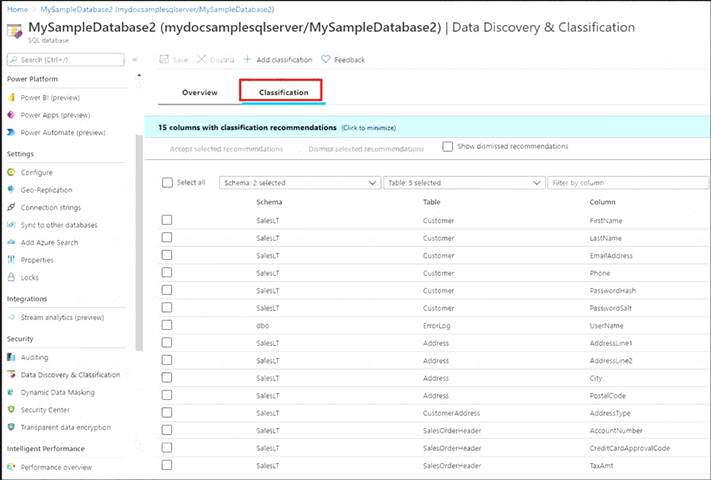- (Exam Topic 3)
You plan to create an Azure Synapse Analytics dedicated SQL pool.
You need to minimize the time it takes to identify queries that return confidential information as defined by the company's data privacy regulations and the users who executed the queues.
Which two components should you include in the solution? Each correct answer presents part of the solution. NOTE: Each correct selection is worth one point.
Correct Answer:
AC
A: You can classify columns manually, as an alternative or in addition to the recommendation-based classification:
 Select Add classification in the top menu of the pane.
Select Add classification in the top menu of the pane. In the context window that opens, select the schema, table, and column that you want to classify, and the information type and sensitivity label.
In the context window that opens, select the schema, table, and column that you want to classify, and the information type and sensitivity label. Select Add classification at the bottom of the context window.
Select Add classification at the bottom of the context window.
C: An important aspect of the information-protection paradigm is the ability to monitor access to sensitive data. Azure SQL Auditing has been enhanced to include a new field in the audit log called data_sensitivity_information. This field logs the sensitivity classifications (labels) of the data that was returned by a query. Here's an example:
Reference:
https://docs.microsoft.com/en-us/azure/azure-sql/database/data-discovery-and-classification-overview
- (Exam Topic 3)
You have an Azure Data Factory pipeline shown the following exhibit.
The execution log for the first pipeline run is shown in the following exhibit.
The execution log for the second pipeline run is shown in the following exhibit.
For each of the following statements, select Yes if the statement is true. Otherwise, select No. NOTE: Each correct selection is worth one point.
Solution:
Does this meet the goal?
Correct Answer:
A
- (Exam Topic 3)
You have an Azure Databricks workspace that contains a Delta Lake dimension table named Tablet. Table1 is a Type 2 slowly changing dimension (SCD) table. You need to apply updates from a source table to Table1. Which Apache Spark SQL operation should you use?
Correct Answer:
C
The Delta provides the ability to infer the schema for data input which further reduces the effort required in managing the schema changes. The Slowly Changing Data(SCD) Type 2 records all the changes made to each key in the dimensional table. These operations require updating the existing rows to mark the previous values of the keys as old and then inserting new rows as the latest values. Also, Given a source table with the updates and the target table with dimensional data, SCD Type 2 can be expressed with the merge.
Example:
// Implementing SCD Type 2 operation using merge function customersTable
as("customers") merge(
stagedUpdates.as("staged_updates"), "customers.customerId = mergeKey")
whenMatched("customers.current = true AND customers.address <> staged_updates.address") updateExpr(Map(
"current" -> "false",
"endDate" -> "staged_updates.effectiveDate")) whenNotMatched()
insertExpr(Map(
"customerid" -> "staged_updates.customerId", "address" -> "staged_updates.address", "current" -> "true",
"effectiveDate" -> "staged_updates.effectiveDate",
"endDate" -> "null")) execute()
}
Reference:
https://www.projectpro.io/recipes/what-is-slowly-changing-data-scd-type-2-operation-delta-table-databricks
- (Exam Topic 3)
You implement an enterprise data warehouse in Azure Synapse Analytics. You have a large fact table that is 10 terabytes (TB) in size.
Incoming queries use the primary key SaleKey column to retrieve data as displayed in the following table:
You need to distribute the large fact table across multiple nodes to optimize performance of the table. Which technology should you use?
Correct Answer:
B
Hash-distributed tables improve query performance on large fact tables.
Columnstore indexes can achieve up to 100x better performance on analytics and data warehousing workloads and up to 10x better data compression than traditional rowstore indexes.
Reference:
https://docs.microsoft.com/en-us/azure/sql-data-warehouse/sql-data-warehouse-tables-distribute https://docs.microsoft.com/en-us/sql/relational-databases/indexes/columnstore-indexes-query-performance
- (Exam Topic 3)
You build a data warehouse in an Azure Synapse Analytics dedicated SQL pool.
Analysts write a complex SELECT query that contains multiple JOIN and CASE statements to transform data for use in inventory reports. The inventory reports will use the data and additional WHERE parameters depending on the report. The reports will be produced once daily.
You need to implement a solution to make the dataset available for the reports. The solution must minimize query times.
What should you implement?
Correct Answer:
A
Materialized views for dedicated SQL pools in Azure Synapse provide a low maintenance method for complex analytical queries to get fast performance without any query change.
Note: When result set caching is enabled, dedicated SQL pool automatically caches query results in the user database for repetitive use. This allows subsequent query executions to get results directly from the persisted cache so recomputation is not needed. Result set caching improves query performance and reduces compute resource usage. In addition, queries using cached results set do not use any concurrency slots and thus do not count against existing concurrency limits.
Reference:
https://docs.microsoft.com/en-us/azure/synapse-analytics/sql-data-warehouse/performance-tuning-materialized- https://docs.microsoft.com/en-us/azure/synapse-analytics/sql-data-warehouse/performance-tuning-result-set-cac

